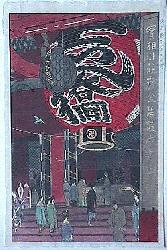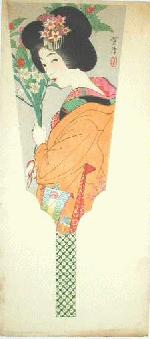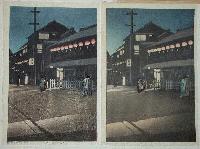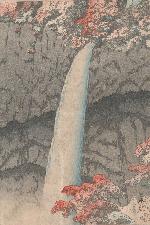These pages contain odd bits of Shin Hanga information that haven't yet found their contextual home in the Articles section or elsewhere. (Send yours in!)
|
Small Flotsam 11 February 2000 One of our members made this observation in an online auction listing: The 1936 Toledo catalog lists 14 Shiro prints, all of them describing the Watanabe copyright seal in the margin, presumably the expected cartouche seals -- all except this print (#173) whose Watanabe copyright seal is described as being present but not necessarily in the margin. This is suggestive, but inconclusive. Toledo 1936 also says this print is dated in the right margin and had an initial edition of 100. The cited Smith print is stated as being from the initial edition of 100, but has no margin date, raising further questions. Another member checked in to report previously seeing "a couple copies [of this print] with the Watanabe C seal", and to point out that the catalog indicates "that particular print was acquired by the museum in 1981". Yet another of our members looked further, and found this Shiro print The very popularity of this image, especially in the postwar tourist boom, could explain why one would see 6 mm versions almost exclusively today. In any case, even if the 6 mm had been used on this print continuously from the 1930's for several decades afterwards, then a collector should consider using other means to help determine the state (early vs. late). Members can view the separate page on Watanabe seals.
| |
|
To the Small Flotsam above, an Addendum 12 February 2000 A disconcertingly large portion of our members actually looked in the book and want to know: "where does it say this print 'was a gift from the artist in 1938'?". Well, it doesn't. But at this point we'll just step aside and let the gentleman speak:
Although Mr. Smith was busy, he very graciously assigned one of his assistants to me, and this fellow (David Bates, as I recall) spent the entire afternoon bringing out box after box of prints for me to peruse. I got to look at everything that was in the show, and probably 500 more shin hanga and sosaku hanga prints that were in the previous show ("The Japanese Print Since 1900") or not featured in either. While I was not allowed to take photographs, I was allowed to take notes; I used up several note pads. I still hadn't finished when the museum closed, and it was dark by the time I got back outside. (It was December.) Anyway, each print bears a notation as to its provenance, and that is what I wrote down for the Shiro print. What may have happened is that some of his 1930's prints bore both the 6 mm seal and the appropriate cartouche, like Shinsui prints, for instance, and that this one slipped through the cracks. That said, I can't remember ever having seen a copy of this print with anything other than the 6mm seal, although there are probably 7 mm examples floating around. Hope that helps some; more likely it muddies up the waters some (sorry about that).
| |
|
Shiro Surprise 13 March 2000
Another print of this series, same style, shows a child with short hair with a snow rabbit. The 1936 Watanabe catalog lists 6 such prints, numbered 1001 through 1006, all by Shiro. The print depicted here is 1006 "A girl arranging flowers". Number 1002 is the print mentioned above, "A girl holding a snow-rabbit", the only one depicted in the catalog.
Battledores were toys in which people of high rank took interest, so that they were gracefully painted, using gold-dust. As there was created a feeling of relief, this work was named the Oshi-E or Pasted Picture. The high-class battledores were used as an ornament, but they did not last long because they were liable to be damaged. My shop has devised a way to preserve them forever by pasting colour-prints on paulownia boards. These tasteful prints can be appreciated just as they are, and they can be employed also for indoor decoration as well as for pillar-hangings. In addition, they are suited for gifts. -- S. Watanabe, 1936
| |
|
Watanabe Blocks 14 July 2000 A member writes: "It seems there are some dimensional differences of Hasui Heisei editions compared with early versions. Please see the image here, where left is the Hesei version and right an early version (no seals, estimated early prewar).
"In another image, where both prints are overlayed, you see that the Heisei version is approx. 5mm smaller at the "short" side.
"I am no expert in paper, can this be explained by shrinking? 5mm shrinking I would accept, but I expect that an older print shrinks more (or maybe, older paper is of higher quality and therefore has more dimensional stability?). Furthermore, shrinking not only happen in one dimension, but also along the "long" side? "What puzzles me more is the writing on the lower margin (actually right to left).
"I would like to know all our visitors' ideas. Send an email. "PS: It is evident that the printing quality of the Heisei versions is lightyears away from the early versions."
| |
|
Jetsam 15 August 2000 Dateline: Tokyo. Noted shin hanga artist Tokuriki Tomikichiro, born 1902 in Kyoto, died July 2000, age 98 years.
| |
|
Toshi 16 December 2000 A member writes: "Although the Yoshida's have not yet found their way to ShinHanga.net, I had a recent discussion about Toshi's pencil and block signatures with Eugene Skibbe, the author of the book Toshi Yoshida - Nature, Art and Peace. He provided me with an interesting statement from Takashi Yoshida, number 2 son of Toshi. The fact is, that already during the lifetime of Toshi some prints got the printed signature instead of the pencil signature." Due to hospitalization and the weakness of his hand, Toshi Yoshida (1911-1995) chose to use a hand printed signature with embossed seal during this period. However, he kept supervising all of the printing at his studio. So, you may find the following signatures for his prints: 1. Original Limited number with his pencil signature.
4. Original Unlimited number with his pencil signature.
Postscript: in 2002, from February to April, the Minneapolis Institute of Arts held a major exhibit on Yoshida Family Art, featuring 7-8 artists from the family. This was the first major exhibit to address the entire family.
| |
|
Cherry Blocks 17 March 2001
By popular request, here are detailed photos of some of the carved cherry wood blocks used to make a shin hanga print. These were recently offered publicly for sale in the Online Gallery of a Japanese dealer. Those kento marks you've read so much about, but perhaps could never visualize? These color blocks all have it, but look closely at the blue color block. You'll see the right-angle cutout, into which the square corner of the paper is pressed. About 2/3 up the same side, is a straight cutout for the long edge of the paper. Now closely examine the square corner of any shin hanga print in your collection. On the reverse side, you'll probably see the scratch marks in the paper, where the print was repeatedly pressed down into the kento corner cutout.
Curious about these specific blocks? If you noticed that the proportions don't seem correct, that's because the print is not oban format. Actually the blocks are about chuban size, 27.8 x 20 cm. This scaled-down copy and its original were produced by Bijutsusha, publisher of 8 Hasui oban prints -- the "New Eight Views" discussed elsewhere here. "Kegon Waterfall" was the first (1927) and one of the most popular of the series, which was replicated later in at least two other formats: Postcard Size and Medium Size (these blocks). We also have the benefit of these comments from our resident nonresident woodblock craftsman: "The blocks have been well used, but not bashed around. There is evidence that a number of different editions have been pulled from them, and here and there we can see marks left by the printer's chisels, as they had to slightly deepen certain regions that were causing blots. (This nearly always happens with blocks after much use.) "The 'finished print' doesn't seem to be an actual finished print, but something partially done ... where's the green?"
| |
|
Temples 18 April 2001 Just something good to know... Ji, tera, dera, or bukkaku = Buddhist temple - from An Official Guide to Nara, published by the Nara Prefectural Government Office, Nara, Japan, November 1925
| |
|
Bleaching 19 September 2001 A site visitor asked a member about the controversial subject of bleaching prints, using ultraviolet and traditional methods. Here's that response: Thank you for your interest in bleaching and your inquiry at ShinHanga.net. Bleaching prints by UV radiation in an aqueous alkaline medium has been investigated since around 1980 mainly by Matsushima-Keyes and is considered "safe" in terms of stability of the paper, compared with other bleaching procedures. The stability of the pigments is of course a different issue and depends on each particular pigment, but my own experiments show that the pigments of relatively modern shin hanga prints (since 1920) are often sufficiently stable under the conditions applied. However, with Meiji prints and old ukiyo-e I would be hesitant. As a UV source you may use natural sunlight or fluorescent lamps, the time required is in typical cases several hours. I accelerate the process by using a "soft" UV source by Philips (an old face-tanning lamp) which filters out the extreme short wavelength UV radiation. Typical time is only 10-45 minutes and the process can be even more accelerated by adding a little Hydrogen Peroxide (approximately 1% solution). The distance of the lamp to the print should be 30 cm. In "The Paper Conservator", 1992, the standard UV method is explained in all details. Most people are afraid that the pigments "dissolve" in the water - they don't. However, I would try to keep the time in the water as short as possible to avoid damage of the paper. A typical procedure for UV bleaching would be as follows: 1) Put the print on a mesh support and rinse it with water for 5 minutes. 2) Wash again with Calcium Hydroxide solution (1 teaspoon per liter) for 5 minutes. Repeat if water is yellow/brown until clear. 3) Keep the print in Calcium Hydroxide solution and radiate with UV, moving it gently from time to time. 4) Wash the print with water several times to remove all products that might result from the bleaching. 5) Important: make a final rinse with Calcium Hydroxide solution to give the paper an alkaline reserve. 6) Dry between blotters. I for myself apply a more complex process combined of peroxide/UV bleaching with a subsequent reductive bleaching step, which stabilizes and even regenerates damaged cellulosis. However, the chemicals involved require experience and equipment for safety reasons. 1) Put the print on a mesh support and rinse it with water for 5 minutes. 2) Wash again with Calcium Hydroxide solution (1 teaspoon per liter) for 5 minutes. Repeat if water is yellow/brown until clear. 3) Keep the print in a mixture of Calcium Hydroxide solution and 1% Hydrogen Peroxide and radiate with UV, moving it gently from time to time. 4) Wash the print with water several times to remove all products that might result from the bleaching. 5) Keep the print for 15 minutes in a solution of Sodium Borohydride (NaBH4). Concentration: 0.5 g in 250 ml water. Warning, this material is dangerous!! This step restores damaged cellulosis - old damage and any caused by the bleaching. 6) Rinse twice with water. 7) Wash 5 minutes in 1% Acetic Acid to remove remaining NaBH4. 8) Rinse with water until neutral. 9) Final rinse with Calcium Hydroxide. 10) Dry. Click below to see images of a Shiro Kasamatsu print (1950) as an example for this combined process. The toning by the mat is removed almost completely. Furthermore, here is an image which compares different bleaching processes. I simply cut (please forgive me) a Hiroshige reprint with heavy foxing into four parts and treated each separately. Here are the results, numbered left to right: 1) UV for 30 minutes 2) untreated 3) UV/Hydrogen Peroxide, 10 minutes 4) Hydrogen Peroxide, 1 hour In case of any questions, please send an email. Also, feel free to send me a jpg of your print, maybe I can provide a more specific advice. ---------------------- The site visitor replied with this: Thanks for your informative reply to my question about UV bleaching. The print in question is a Yoshida with jizuri and brush signed. My concern about using any liquid is that the signature is unstable and would wash off. Here's our member's reply: A brush signature is certainly an obstacle for a wet treatment, because we do not know whether the pigment is stable against water or not. Although I treated with success two jizuri Yoshida prints ("Horikiri Iris Garden" and "Himeji Castle, Morning"), I never checked whether the signature was brushed or in block. You could test the stability of the brush signature with a wet cotton swab - roll it over the signature, but do not rub. If the signature is water soluble, there are two ways: 1) mask the signature temporarily (e.g., with methyl cellulosis and subsequent "Liquid Mask" by Winsor & Newton), or 2) Bleach non-aqueous in the vapor phase with Chlorine or Chlorodioxide. Whereas method 1 can be applied by an experienced home restorer, for safety reasons I strictly warn about method 2, because Chlorine is highly toxic and Chlorodioxide apart from toxicity is very explosive! Therefore, in your case, your print should be given to a restorer who has the equipment for handling your needs.
---------------------- And here's one more example, an early Hasui print:
The print had been severely toned by sunlight, and several cracks had developed in the paper (visible in the image). UV bleaching reduced the toning significantly, and the cracks were stabilized with patches verso.
| |
|
Tourists 20 October 2001 Q: "How many shin hanga prints were 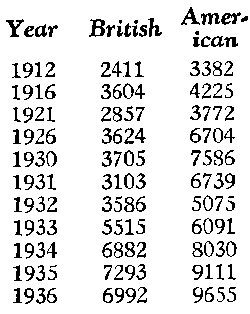
This can only be roughly estimated at best, but how to even approach this? One way is to start with the potential market size, which is why this chart caught our eye. These figures are official tourist counts, available for certain years only, from the Japan Tourist Bureau. Click on the image for the full chart. "Foreigners Served" probably means assistance provided to a tourist at a JTB office. These figures might seem surprisingly low, especially by modern standards. But anyway the hard part would come next: what portion of these tourists might have bought shin hanga prints, and how many prints (on average) per purchase? Suggestions welcome. - from The Silver Jubilee of the Japan Tourist Bureau, Tokyo: 1937.
|
|
|
|
